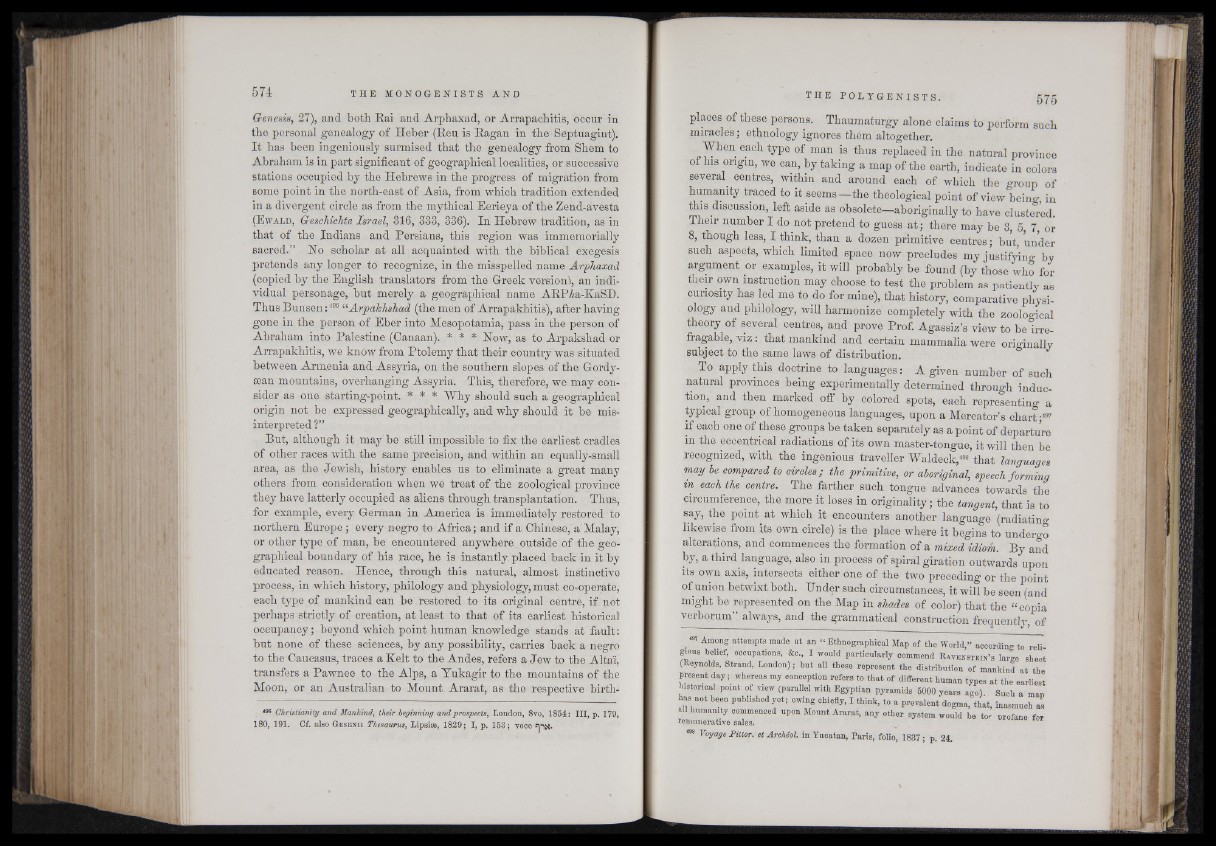
Genesis, 27), and both Eai and Arphaxad, or Arrapachitis, occur in
the personal genealogy of Heber (Reu is Eagan in the Septuagint).
It has been ingeniously surmised that the genealogy from Shem to
Abraham is in part significant of geographical localities, or successive
stations occupied by the Hebrews in the progress of migration from
some point in the north-east of Asia, from which tradition extended
in a divergent circle as from the mythical Eerieya of the Zend-avesta
(E wald, Geschichte Israel, 316, 333, 336). In Hebrew tradition, as in
that of the Indians and Persians, this region was immemorially
sacred.” Ho scholar at all acquainted with the biblical exegesis
pretends any longer to recognize, in the misspelled name Arphaxad
(copied by the English translators from the Greek version!, an individual
personage, but merely a geographical name AEPAa-KaSD.
Thus Bunsen:498 “Arpalchshad (the men of Arrapakhitis), after having
gone in the person of Eber into Mesopotamia, pass in the person of
Abraham into Palestine (Canaan). * * * How, as to Arpakshad or
Arrapakhitis, we know from Ptolemy that their country was situated
between Armenia and Assyria, on the southern slopes of the Gordy-
sean mountains, overhanging Assyria. This, therefore, we may consider
as one starting-point. * * * Why should such a geographical
origin not be expressed geographically, and why should it be misinterpreted
?”
But, although it may' be still impossible to fix the earliest cradles
of other races with the same precision, and within an equally-small
area, as the Jewish, history enables us to eliminate a great many
others from consideration when we treat of the zoological province
they have latterly occupied as aliens through transplantation. Thus,
for example, every German in America is immediately restored to
northern Europe ; every negro to Africa; and if a Chinese, a Malay,
or other type of man, be encountered anywhere outside of the geographical
boundary of his race, he is instantly placed back in it by
educated reason. Hence, through this natural, almost instinctive
process, in which history, philology and physiology, must co-operate,
each type of mankind can be restored to its original centre, if not
perhaps strictly of creation, at least to that of its earliest historical
occupancy; beyond which point human knowledge stands at fault:
but none of these sciences, by any possibility, carries back a negro
to the Caucasus, traces a Kelt to the Andes, refers a Jew to the Altai,
transfers a Pawnee to the Alps, a Yukagir to the mountains of the
Moon, or an Australian to Mount, Ararat, as the respective birth498
Christianity and Mankind, their beginning and prospects, London, 8vo, 1854: III, p. 179,
180, 191. Cf. a l s o G e s e n i i Thesaurus, Lipsise, 1829; I , p. 153; v o c e
places of these persons. Thaumaturgy alone claims to perform such
miracles; ethnology ignores them altogether.
When each type of man is thus replaced in the natural province
of his origin, we can, by taking a map of the earth, indicate in colors
several^ centres, within and around each of which the group of
humanity traced to it seems—the theological point of view being in
this discussion, left aside as obsolete—aboriginally to have clustered.
Their number I do not pretend to guess at; there may be 3, 5, 7, or
8, though less, I think, than a dozen primitive centres; but, under
such aspects, which limited space now precludes my justifying by
argument or examples, it will probably be found (by those who for
their own instruction may choose to test the problem as patiently as
curiosity has led me to do for mine), that history, comparative physiology
and philology, will harmonize completely with the zoological
theory of several centres, and prove Prof. Agassiz’s view to be irrefragable,
v iz : that mankind and certain mammalia were originally
subject to the same laws of distribution.
To apply this doctrine to languages: A given number of such
natural provinces being experimentally determined through induction,
and then marked oft by colored spots, each representing a
typical group of homogeneous languages, upon a Mercator’s chart;497
if each one of these groups be taken separately as a point of departure
in the eccentrical radiations of its own master-tongue, it will then be
recognized, with the ingenious traveller Waldeck,498 that languages
may he compared to circles; the primitive, or aboriginal, speech forming
in each the centre. The farther such tongue advances towards the
circumference, the more it loses in originality; the tangent, that is to
say, the point at which it encounters another language (radiating
likewise from its own circle) is the place where it begins to undergo
alterations, and commences the formation of a mixed idiom. By and
by, a third language, also in process of spiral giration outwards upon
its own axis, intersects either one of the two preceding or the point
of union betwixt both. Under such circumstances, it will be seen (and
might be represented on the Map in shades of color) that the “ copia
verborum” always, and the grammatical construction frequently, of
_497 Among attempts made at an “ Ethnographical Map of the World,” according to reli
gious belief, occupations, &c., I would particularly commend R av enstein' s large sheet
(Reynolds, Strand, London); but all these represent the distribution of mankind at the
present day; whereas my conception refers to that of different human types at the earliest
historical point of view (parallel with Egyptian pyramids 6000 years ago). Such a man
has not been published yet; owing chiefly, I think, to a prevalent dogma, that, inasmuch as
all humanity commenced upon Mount Ararat, any other system would be tor nrofane for
remunerative sales.
498 Voyage Pittor. et Archiol. in Yucatan, Paris, folio, T837; p. 24.